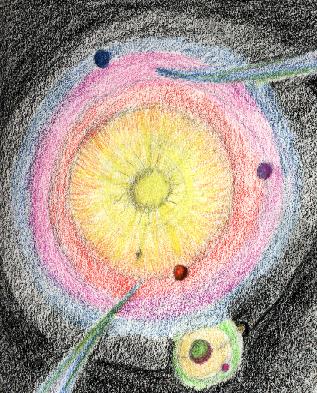[Seasons, weeks and days]
[Small amounts of time]
[Era's]

The Fon-system: Fon is in the middle, Airtha, the green planet, near the lower right corner, with its two satellites.
Years and months
The World of Daleth, known as Airtha, is a planet that circles a small star named Fon (meaning: “Fire”). It takes 360 days to complete its orbit, so a year is 360 days.But not for the Naglani.
The year starts when Fon reached a special place in the sky. There are sundials to see which day it is, by measuring the length and direction of a pole-shadow. These sundials are not designed to measure the hours of the day!
Airtha has two satellites, or moons. The first Moon, Lukarna (“Latern”) orbits around Airtha in 24 days. Each month has 24 days, a year has 15 months. The Naglani count a year as 16 Menoth (months) of 24 days. They refer to the 360-days-year as Bisunjane and to the 384-days-year as Athns. These Menoths are not in pace with the seasons, a relict from the time the Naglani weren’t farmers, but hunters, and didn’t have to know when to sew the seeds.
The second moon, Twabaírhtei (The Second Light) has been discovered only recently and has no effect on time.
Seasons, weeks and days
A month or Menoth has four weeks of six days each. The days are called simply First, Second, ..., Last. Two Naglani-menoth make a Twozmenoth, also known as seasons. A year, be it an Athns or a Bisunjane, has eight seasons.To get 15 months fit in eight seasons, the people from Overveer changed their calendar by making each month 7 weeks plus 3 holidays (named “First Holiday, Second Holiday, Last Holiday”). This way, they had eight Twozmenoth or seasons. The system was followed by many countries, mostly because the 3 holidays sounded appealing.
[More information about Seasons and Holy Days]
[Back to top]
Small amounts of time
A day is devided into eight stondes. Four stondes are in the night, the other four in daylight. The first stonde of the day (Dawn) begins with sunrise, the first of the night with the setting of the sun (Dusk). Midnight and Midday are the beginning of respectively the third stonde of the night and the day.The stondes are not equally long. In summer, the nightstondes are shorter than the daystondes. Because distances between places are measured in stondes, the distances may vary from summer to winter, and from day to night.
People might use the new coined word Springstond to indicate the lenght of a day on the spring equinox. Springstond is only used with the Dayglass as reference.
Counting the era’s
It was always difficult to find a universal way to measure era’s. What was a good part to start with 0 when the age of Airtha itself was not known? The most important point zero for most people was the year in which they first came to Airtha, the first time they went through the Portal. So most people start to count their “Opening of the Portal”.The era’s are seperated as “1200 after the second opening of the portal”, “3 after the third opening of the Portal”. In Daleth, it is now over 1800 years after the first opening of the Portal (See Calendar for exact date and year). No-one knows if it really was the first opening, but it was nevertheless one of the most important openings.
Related topics: